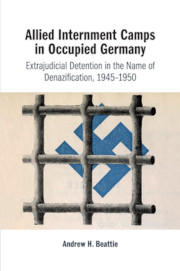 Allied Internment Camps in Occupied Germany
Allied Internment Camps in Occupied Germany Book contents
- Allied Internment Camps in Occupied Germany
- Allied Internment Camps in Occupied Germany
- Copyright page
- Dedication
- Contents
- Illustrations
- Acknowledgements
- Abbreviations
- Introduction
- 1 ‘It Will Be Desirable on Political Grounds’
- 2 ‘Not Consistent with Civil Liberties’
- 3 Internees
- 4 Internment Camps
- Conclusion
- Glossary of German Terms
- Bibliography
- Index
4 - Internment Camps
‘The Main Task of the Camp Is the Complete Isolation’ of the Detainees
Published online by Cambridge University Press: 28 October 2019
- Allied Internment Camps in Occupied Germany
- Allied Internment Camps in Occupied Germany
- Copyright page
- Dedication
- Contents
- Illustrations
- Acknowledgements
- Abbreviations
- Introduction
- 1 ‘It Will Be Desirable on Political Grounds’
- 2 ‘Not Consistent with Civil Liberties’
- 3 Internees
- 4 Internment Camps
- Conclusion
- Glossary of German Terms
- Bibliography
- Index
Summary
Chapter 4 examines the sites and functions of the camps and the treatment and conditions to which internees were subjected. It shows that there were more camps than often believed, especially in the west, and that although most had a Nazi past only a minority were former concentration camps. It shows that the camps served multiple functions (including holding SMT convicts) and operated under changing authority, especially in the US zone with a shift to German administration in 1946 and the Soviet zone with subordination to the Gulag in 1948. The chapter shows that after initial similarities in internees’ isolation, poor conditions, and rough treatment, crucial differences emerged between the western and the Soviet zones. Soviet internees remained isolated from the outside world, had limited opportunities for work or other meaningful activity, and remained inadequately accommodated, clothed, and most importantly fed. As a result, over 40,000 died from starvation and related diseases and were buried in mass graves. Soviet authorities’ failure to stop the mass dying stands in contrast to the western powers’ effective responses to early malnutrition. Nevertheless, the chapter argues that the western camps were not always the transparent, peaceful sites of re-education they are sometimes taken for.
Keywords
- Type
- Chapter
- Information
- Allied Internment Camps in Occupied GermanyExtrajudicial Detention in the Name of Denazification, 1945–1950, pp. 144 - 189Publisher: Cambridge University PressPrint publication year: 2019
